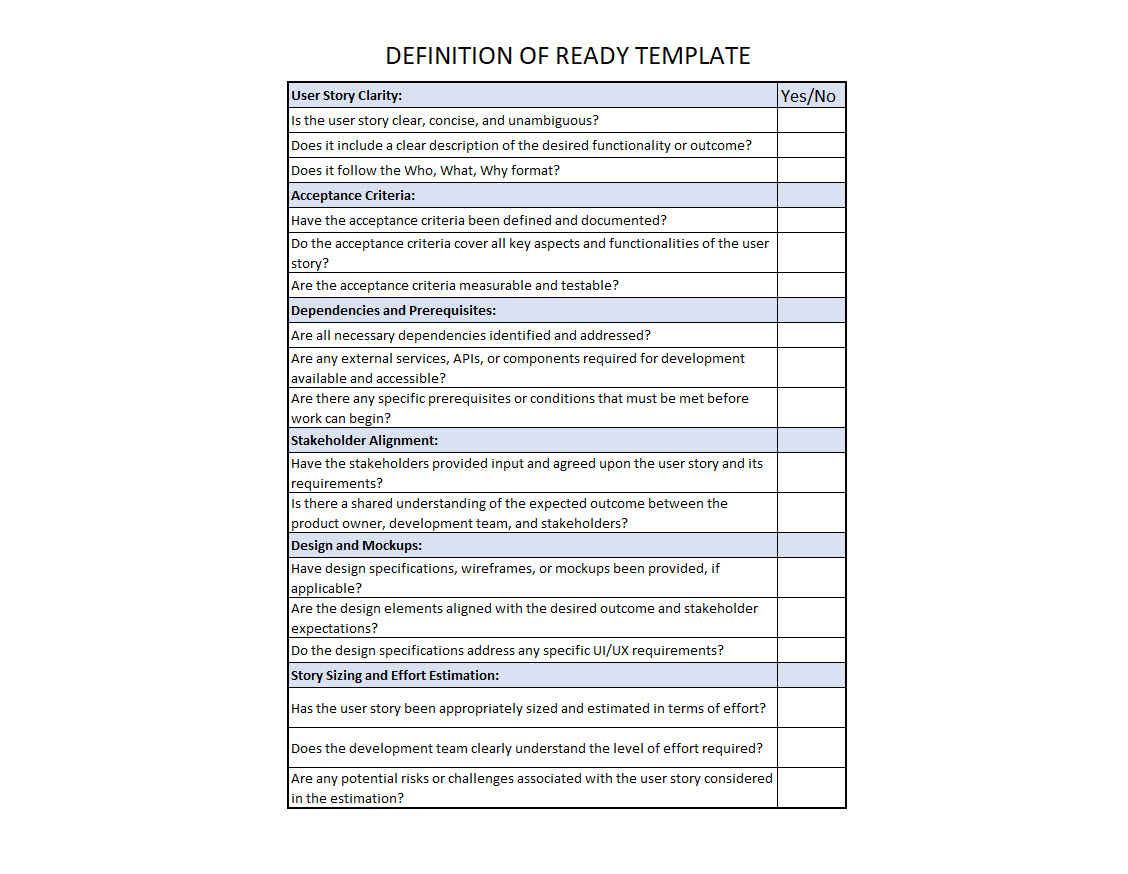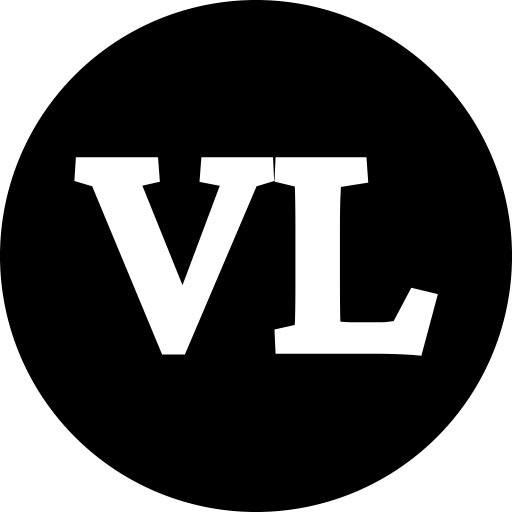Table of Contents
What is the Definition of Ready
The Definition of Ready (DoR) is commonly used in Agile software development methodologies, particularly in Scrum. It refers to a set of criteria or guidelines that a user story must meet before it is deemed ready to be taken up by the development team for implementation during a sprint.
The Definition of Ready is collaboratively established by the product owner and the development team, and it serves as a checklist to ensure that the necessary information and conditions are in place to work on the item effectively.
By establishing a shared understanding of what constitutes a “ready” user story, the team can ensure smoother sprint planning, minimize interruptions during development, and improve overall productivity and collaboration.
Definition of Ready Examples
Checklist Example
In this example, the readiness criteria are listed as a list or in a table, followed by questions.
For example:
User Story Clarity:
- Is the user story clear, concise, and unambiguous?
- Does it include a clear description of the desired functionality or outcome?
- Does it follow the Who, What, Why format?
Acceptance Criteria:
- Have the acceptance criteria been defined and documented?
- Do the acceptance criteria cover all key aspects and functionalities of the user story?
- Are the acceptance criteria measurable and testable?
Dependencies and Prerequisites:
- Are all necessary dependencies identified and addressed?
- Are any external services, APIs, or components required for development available and accessible?
- Are there any specific prerequisites or conditions that must be met before work can begin?
Stakeholder Alignment:
- Have the stakeholders provided input and agreed upon the user story and its requirements?
- Is there a shared understanding of the expected outcome between the product owner, development team, and stakeholders?
Design and Mockups:
- Have design specifications, wireframes, or mockups been provided, if applicable?
- Are the design elements aligned with the desired outcome and stakeholder expectations?
- Do the design specifications address any specific UI/UX requirements?
Story Sizing and Effort Estimation:
- Has the user story been appropriately sized and estimated in terms of effort?
- Does the development team clearly understand the level of effort required?
- Are any potential risks or challenges associated with the user story considered in the estimation?
Remember to adapt and customize this checklist to suit your Agile team’s specific needs and requirements. Regularly review and refine the checklist based on your team’s experiences and feedback to ensure its effectiveness in defining readiness and setting the stage for successful development.

INVEST Examples
This example uses the INVEST acronym as a structure for the DoR, where each letter represents a readiness criterion.
For example:
I – Independent:
- Can it be worked on and completed without relying on other stories?
- If there are dependencies, are they separated and refined?
- Can the team complete this work without relying on other teams?
N – Negotiable:
- Was the story discussed and does the team fully understand what needs to be done?
- Are the acceptance criteria defined?
- Is there a high-level technical solution in place and the team can start working on the story?
V – Valuable:
- Does the user story provide value to the end-users or stakeholders?
- Does it align with the project goals and objectives?
- Does it follow the Who, What, Why format?
E – Estimable:
- Can the development team estimate the effort and complexity of the user story?
- Are the requirements and acceptance criteria clear enough to allow for accurate estimation?
S – Small:
- Is the user story small enough to be completed within a single iteration or sprint?
T – Testable:
- Can the user story be tested to ensure that the desired outcome or functionality is achieved?
- Are the acceptance criteria well-defined and specific enough to guide the testing process?
By using the INVEST criteria as a foundation for your Definition of Ready, you ensure that the user stories are well-prepared, independent, valuable, estimable, small, and testable. This checklist helps promote clarity, collaboration, and effective planning, setting the stage for successful development and delivery of high-quality increments.

Downloadable DoR Templates
Definition of Ready Best Practices
While specific practices may vary depending on the team and project, here are some general best practices for creating and using a Definition of Ready (DoR):
- Collaborative Definition: Involve both the product owner and the development team in defining the criteria for readiness. This ensures a shared understanding and alignment between the two parties.
- Clearly Communicate DoR Criteria: Document the DoR criteria in a clear and easily accessible format, such as a checklist or a shared document. Make sure everyone on the team understands the expectations for a user story to be considered “ready.”
- Tailor DoR to the Team: Adapt the DoR criteria to fit your team and project’s specific needs and context. Consider factors such as team maturity, domain complexity, and technological considerations.
- Continuously Refine DoR: Regularly review and refine the DoR criteria based on feedback from the team’s experiences. Consider adding or modifying criteria to improve the effectiveness of the readiness assessment.
- Involve QA and Testing: Include quality assurance (QA) and testing team members in defining the DoR criteria. This helps ensure that all necessary testing considerations are included in the readiness assessment.
- Early Engagement of the Development Team: Encourage the development team’s active involvement in grooming and refining user stories before they are added to the backlog. This helps identify and address any gaps or uncertainties early on.
- Balance Flexibility and Clarity: The DoR should provide clear guidelines for readiness without being overly prescriptive. Allow some flexibility to accommodate unique situations while maintaining clarity and consistency.
- Educate Stakeholders: Educate stakeholders, including the product owner and other team members, on the importance and purpose of the DoR. Foster a culture where everyone understands and values the concept of readiness.
- Regularly Review and Assess: During backlog refinement sessions or sprint planning meetings, review user stories against the DoR criteria. Assess readiness collaboratively and transparently, making any necessary adjustments or clarifications.
- Continuous Improvement: Treat the DoR as an evolving tool and continuously seek ways to improve it. Encourage feedback from the team and be open to refining the criteria based on lessons learned and changing project dynamics.
Let me know in the comments which DoR format you’ve used. How does it work for your team?


1 comment
[…] Download the Definition of Ready templates […]
Comments are closed.